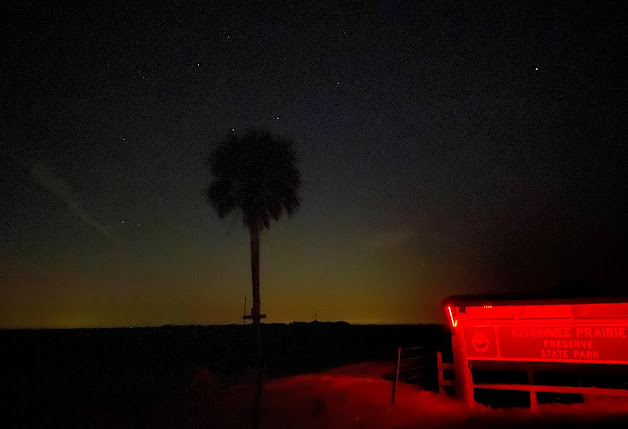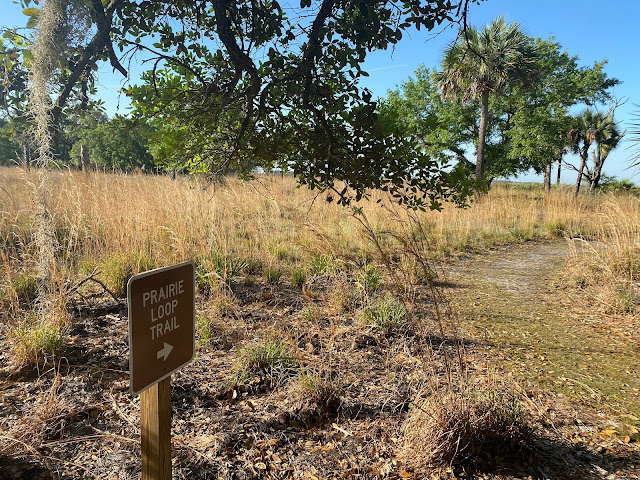87 & 88: Florida Prairies & Blowing Rocks
F L O R I D A
Kissimmee Prairie (87)
Okeechobee,
Florida
Vast
& Humbling
I exit Florida’s
Turnpike at Yeehaw Junction and drive into a dense darkness. I’m a lone traveler on a now-thinner road no
longer surrounded by the highway’s luminance.
Suddenly my headlights seem quite feeble. The feebleness though, is a good sign. I’m deliberately headed toward the state’s
darkest place – Kissimmee Prairie Preserve State Park (KPPSP).
When I arrive, two
hours before sunrise, the gate is closed.
An expected obstacle. The park
doesn’t open until 8:00 but surmised that even at its gate the stars would be
magnificent. The early arrival was just
the first of three things to have lined up perfectly. Today is also a new moon, meaning it’s just a
sliver of distracting light in the sky, plus there is not a single cloud to be
found, awarding ideal stargazing conditions.
I hop onto the trunk
of my rental car, lean back, and there it is – the Milky Way. Something unseen in over a decade. Like staring into the ocean, I fall into a
trance gazing humbly outward into an endless sea of twinkles. As my eyes adjust, the starlight becomes even
more pronounced. In the stillness, a
gentle, rhythmic lullaby of crickets is occasionally broken by a coyote
howl. My breathing slows and falls into
cadence with the environment. That some
of those twinkles have been travelling at light-speed for millennia is nearly
incomprehensible.
But falling into a
trance is not the main reason I’ve come to Kissimmee Prairie. It represents the 87th Nature
Conservancy-related property visited in a quest to see one hundred. In the 1990’s, when this park was forming,
much of the flora and fauna were inventoried using Nature Conservancy
processes. Those processes have now
morphed into the state’s primary tool for gathering, interpreting, and
disseminating information critical to Florida's biological diversity. Additionally, The Nature Conservancy helps
manage the health of this park’s amazing prairie by engaging in prescribed burns,
including March of 2021 when the largest such burn in state history was ablaze
here.
When the sun rises,
the vastness of the open land is as humbling as the stars. KPPSP is in Florida’s cattle ranch territory
– where cracker cowmen and pickups roam.
The ranches here are shockingly large.
It’s easy to imagine cattle ranches in Texas, but they exist in the
sunshine state too. Fenced fields
peppered with cows and cabbage palm trees stretch on endlessly… as does this
park. Fifty thousand acres of humbling
protected vastness. The Kissimmee
Prairie is where Floridians came come to breathe.
Laced atop this
park’s expansiveness are one-hundred miles of trails. Unlike the twinkles which have traveled an
incomprehensibly long time, my travel time at KPPSP is limited. Later today, I’m off to see yet another
Nature Conservancy property – number 88.
It’ll require a two-hour drive, much of which will be past those
enormous ranches. With only the morning
hours to explore this prairie, I meander a mere four miles of trails. What’s not mere though is the openness. Off to the horizon in any direction, nothing
but wild prairie dotted with palm-laced hammock islands.
I set out on the
Military Trail heading west – a favored direction of travel. My shadow leads the way. The prairie is abuzz with sweet songs of the
meadowlark; their bright yellow breasts and desire to sing as the sun rises
make them easy to spot. Back in
Virginia, sightings are rare, but here at KPPSP meadowlarks have ganged
up.
As the trail narrows,
the adrenaline of arriving at this amazing place settles and I slow down. My senses are now more focused, and I spot a
young gator in the remnants of a drying pond.
Though still officially listed as endangered, spotting gators in Florida
and other southeastern states has become commonplace. Even spotted one at the airport between
runways when flying in yesterday. The
Endangered Species Act of 1973 has made a difference to this keystone species.
I next turn onto the
Prairie Loop Trail which starts out following the contours of a sizable hammock
island. It weaves between large palms
along the edge of a field which I suspect was recently burned; perhaps part of
the 2021 record burn. The groundcover in
this area is much younger than other parts of the prairie, and tree trunks are
blackened.
On a map, the hammock
I’m walking through seems relatively short.
I figured I’d pass through it with ease to where it pokes out the other
side at a spot truly highlighting the vastness of the prairie. But the trail through the hammock
is so lovely and chock full of distractions that my pace slows much lower than
planned. I spend way too much time
chasing a Pileated Woodpecker. Every
time I get close enough to frame up a picture, he flies off to the next
tree. He’s Lucy and I’m Charlie
Brown.
When the trail finally
pokes into the openness it’s as amazing as anticipated. I walk a hundred yards out into the prairie
which is now ablaze in magnificent sunshine.
It feels as if I’ve taken the stage.
There’s nowhere for a six-foot man to hide in an expanse of newly sprouted
ground cover. I know instantly the
imagery on this stage will burn a deep and long-lasting memory.
Kissimmee Prairie
Preserve State Park in conjunction with the work of The Nature Conservancy have
afforded two amazing experiences this morning - gazing up at the vastness of
the Milky Way, then later poking out into an unending prairie. Rare and humbling experiences, especially so
in the eastern United States. An extreme
early departure this morning to have captured both have already made this an
incredibly memorable day… and its only half done.
Blowing Rocks Preserve (88)
Hobe Sound, Florida
One Grain at a Time
Flying from DC to
Orlando yesterday, our flightpath led out over the Atlantic for a bit. It came back ashore over Daytona where the
oval raceway clearly identified the location.
What was also clear from up high was the extensive development of
Florida’s shore. As far as could be
seen, high risers poked up from oceanfront drives; their shadows in the late
afternoon revealing their height.
Further down the
coast, far beyond sight, is the second of two Nature Conservancy (TNC)
properties I’ve come to see on this trip.
It’s a place where no high risers exist.
What does exist though is something you don’t expect in Florida – a
rocky shoreline.
At Blowing Rocks
Preserve on Jupiter Island, a strand of Anastasia limestone pokes above the
surface and intersects the crashing waves.
At high tide, those waves pound the limestone and create blowing
geysers. Though this phenomenon occurs
in a few other rare spots along Florida’s coast, Blowing Rocks harbors the most
iconic intersection.
Driving to Blowing
Rocks leads through congestion – a lot of stoplights, pedestrians, and rights
of way to navigate. Usually when
traveling to TNC preserves, the drive is more pastorale. Eventually though, I spot the preserve’s
sign and the road continuing north up the barrier island leaves all development
behind. The ecological value and
protection provided by this property is starkly apparent.
At the parking lot, I
nab the last available spot. People
milling about give the air being of here for some beach fun. And when I emerge out onto the beach, it’s
peppered with just that – people enjoying the beach.
A child being buried in sand
A grandparent
splashing in the waves with a grandchild.
Twentysomethings
tanning in thongs.
Not happenings you
expect to see at TNC properties.
A little further down
the beach though, past the buried kids and sunbathers, the limestone meets the
sea. Seems only the nature-gawkers like
me have walked this far down the beach.
As I get closer, sharp limestone edges hidden in the sand poke my bare
feet. Maybe this is what kept the
beachgoers away.
Stepping now more cautiously, I meander atop and below the limestone as the
waves move in. It’s not high tide so the
rocks are not blowing, but low tide allows a more textural study of the
limestone. I angle my cameras to crop
out distant buildings and other gawkers, concentrating the view on the cool
namesake found at this preserve.
It’s a battle ground
of water and rock. How long can this
limestone withstand the unrelenting onslaught of waves? Water always wins in these wars, especially
so in an era of rising seas. Victory
comes one grain at a time. The scale of
time in this battle is disorientating to a lowly, tenuous human here for just a
brief visit.
I return north, past
the throngs and thongs, to reach the trail back to the parking lot. Here though, another trail continues to the
other end of the property. This less
popular trail parallels the shore for a half mile under a Seagrape allée. It’s a beautiful, shaded stroll through a
tunnel of diverse subtropical plants unique to the preserve’s coastal
ecology. This property was once overrun
by non-native plants, but the Seagrape and other native plants, some grown in
an on-site nursery, have returned this habitat into what it was before high
risers took over the coast.
When the trail spills
out onto the beach, I’m all alone. No
one to be seen in either direction. It’s
just me and a few staked off leatherback sea turtle nests. This sandier, protected beach here attracts
as many as 1,000 sea turtle nests in a season – a clear numeric measure of the
importance of Blowing Rocks Preserve.
The solitude suddenly
brings a return to that familiar feeling attained at TNC preserves. Being away from the crowds draws attention to
the unique ecological character of a place.
And here at Blowing Rocks, that character is found not just in the
spotlighted limestone, but also in its subtleties. Like the Seagrape covered dune, the richness
of other flora, the protected nesting sites, and the barren stretch of beach
devoid of high riser shadows.
Frankly, I guess, its
character also does include offering beachy experiences like burying a child in
the sand. But maybe that buried girl
will someday connect the dots when recalling her experience here. Perhaps when she’s a grandparent splashing
with her grandchild in the waves that are still at war with the limestone,
she’ll more fully understand the power of preserved places like TNC’s Blowing
Rocks.
DONATE TO TNC HERE.










Test
ReplyDelete